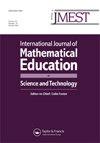为激励和教学基于神经网络的方法来解决微分方程的识字编程
IF 0.6
Q3 EDUCATION & EDUCATIONAL RESEARCH
International Journal of Mathematical Education in Science and Technology
Pub Date : 2023-09-19
DOI:10.1080/0020739x.2023.2249901
引用次数: 0
摘要
摘要在本文中,我们介绍了一种新颖的教学方法,让学生利用数据建模来激励和教授微分方程。具体来说,我们介绍了一个教学框架,该框架将在实时教学中通过存储库和笔记本环境执行教学模块来教授微分方程的不同解技术。每个教学模块都采用识字编程方法,使用笔记本环境以自然语言(如英语)解释概念,并在web浏览器上穿插宏片段和传统源代码。所采用的教学方法是可重复的,并为学生提供开放获取的材料,以有效地激励和教授微分方程。我们将分享这个框架应用于教授高级概念的例子,如机器学习和神经网络方法,用于求解常微分方程和偏微分方程,以及对给定数据集估计这些方程中的参数。更多的工作细节可以访问https://aoguedao.github.io/teaching-ml-diffeq.Keywords:识字编程微分方程机器学习致谢作者也非常感谢匿名审稿人,他们的反馈非常有用。披露声明作者未报告潜在的利益冲突。本研究得到了美国国家科学基金会的部分支持[资助号:DMS-2031029和DMS-2230117]。本文章由计算机程序翻译,如有差异,请以英文原文为准。
Literate programming for motivating and teaching neural network-based approaches to solve differential equations
AbstractIn this paper, we introduce novel instructional approaches to engage students in using modelling with data to motivate and teach differential equations. Specifically, we introduce a pedagogical framework that will execute instructional modules to teach different solution techniques for differential equations through repositories and notebook environments during real-time instruction. Each of these teaching modules employs a literate programming approach that uses the notebook environment to explain the concepts in a natural language, such as English, interspersed with snippets of macros and traditional source code on a web browser. The pedagogical approach employed is reproducible and leads to openaccess material for students to motivate and teach differential equations efficiently. We will share examples of this framework applied to teaching advanced concepts such as machine learning and neural network approaches for solving ordinary and partial differential equations as well as estimating parameters in these equations for given datasets. More details of the work can be accessed from https://aoguedao.github.io/teaching-ml-diffeq.Keywords: Literate programmingdifferential equationsmachine learning AcknowledgmentsThe authors are also very grateful to the anonymous reviewers whose feedback was very useful.Disclosure statementNo potential conflict of interest was reported by the authors.Additional informationFundingThis work is partially supported by the National Science Foundation [grant numbers DMS-2031029 and DMS-2230117].
求助全文
通过发布文献求助,成功后即可免费获取论文全文。
去求助
来源期刊

International Journal of Mathematical Education in Science and Technology
EDUCATION & EDUCATIONAL RESEARCH-
CiteScore
3.30
自引率
11.10%
发文量
123
期刊介绍:
Mathematics is pervading every study and technique in our modern world, bringing ever more sharply into focus the responsibilities laid upon those whose task it is to teach it. Most prominent among these is the difficulty of presenting an interdisciplinary approach so that one professional group may benefit from the experience of others. The International Journal of Mathematical Education in Science and Technology provides a medium by which a wide range of experience in mathematical education can be presented, assimilated and eventually adapted to everyday needs in schools, colleges, polytechnics, universities, industry and commerce. Contributions will be welcomed from lecturers, teachers and users of mathematics at all levels on the contents of syllabuses and methods of presentation.
 求助内容:
求助内容: 应助结果提醒方式:
应助结果提醒方式:


